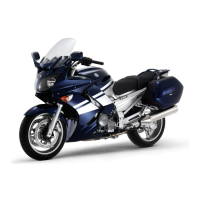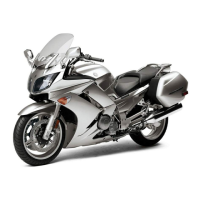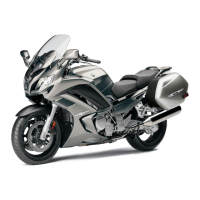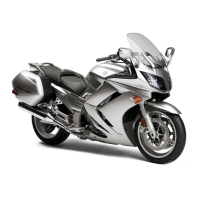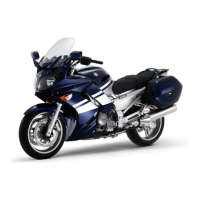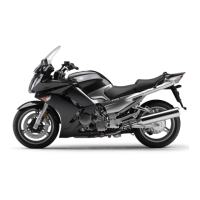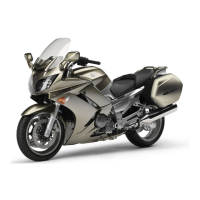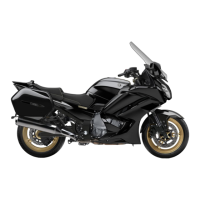Do you have a question about the Yamaha FJR1300AP and is the answer not in the manual?
Provides a welcome message and explains the manual's purpose for safe operation and maintenance.
Explains how to interpret warning, caution, and note notations used throughout the manual.
Outlines essential requirements and knowledge for safe motorcycle operation.
Details necessary safety gear like helmets, jackets, and boots for rider protection.
Provides instructions and precautions for adding accessories or cargo to the motorcycle.
Offers advice on using non-Yamaha accessories and electrical accessory safety.
Details safety measures concerning gasoline handling and exhaust fume exposure.
Provides crucial safety instructions for parking the motorcycle to prevent accidents.
Identifies and locates key components visible on the left side of the motorcycle.
Identifies and locates key components visible on the right side of the motorcycle.
Details the location and function of handlebar controls and dashboard instruments.
Explains the vehicle's anti-theft immobilizer system and proper key usage.
Describes how to operate the main switch for ignition, lighting, and steering lock.
Introduces and illustrates various indicator and warning lights on the instrument panel.
Details the meaning and function of specific indicator and warning lights.
Details the operation and purpose of the speedometer and tachometer.
Explains the features of the multi-function display, including odometer and tripmeters.
Describes how to set the clock and interpret the fuel meter readings.
Explains displays for coolant temperature, transmission gear, and ambient conditions.
Details display modes for ambient temperature and fuel consumption data.
Outlines display modes for ambient temperature and fuel consumption specific to the UK market.
Explains the vehicle's diagnostic system for identifying electrical circuit issues.
Information on the optional alarm and functions of handlebar controls.
Details the operation of windshield, horn, engine stop, start, and hazard switches.
Explains the operation of the clutch lever and the shift pedal for gear changes.
Describes operation of brake controls and the Anti-lock Brake System.
Instructions for opening and closing the fuel tank cap securely.
Details recommended fuel types and safe refueling practices.
Information on fuel tank hose checks, catalytic converter, and seat removal.
Instructions on how to adjust the seat to two different height positions for rider comfort.
Details the procedure for changing the seat height between low and high positions.
Information on the location, capacity, and load limits of the storage compartment.
Instructions for accessing the accessory box and adjusting headlight beam height.
Information on adjusting handlebar position and tilting cowlings for airflow.
Instructions for folding mirrors and adjusting front fork spring preload.
Details how to adjust rebound and compression damping on the front fork.
Instructions for adjusting spring preload and rebound damping on the rear shock absorber.
Explains how to use and adjust the grip warmer temperature control.
Covers the sidestand's function and its role in the ignition circuit cut-off system.
Details the functions of the ignition circuit cut-off system involving multiple switches.
Provides a step-by-step procedure to verify the proper operation of the ignition cut-off system.
Instructions for using the 12V auxiliary DC power outlet safely.
Emphasizes the owner's responsibility for performing essential checks before each ride.
Lists key components and systems requiring inspection before operating the motorcycle.
Explains the conditions and procedures for safely starting the motorcycle's engine.
Details proper gear shifting procedures and important operational cautions.
Offers advice on improving fuel economy and guidelines for the initial engine break-in period.
Provides essential safety instructions for parking the motorcycle to prevent hazards.
Identifies the tools included in the owner's kit for basic maintenance and minor repairs.
A comprehensive chart outlining maintenance intervals for various components.
Step-by-step guide for removing and reinstalling various body panels for maintenance access.
Details the process for checking, gapping, and replacing spark plugs for engine health.
Procedures for checking engine oil level and replacing the oil filter cartridge.
Instructions for inspecting and changing the final gear oil for drivetrain lubrication.
Procedures for checking coolant level and changing the coolant fluid.
Guides on cleaning the air filter element, with precautions for dusty or wet conditions.
Explains checks for engine idling speed, throttle cable play, and valve clearance.
Instructions for checking tire condition, tread depth, and maintaining correct air pressure.
Details approved tire models, valves, and essential inspection points.
Provides guidelines for checking cast wheels for damage, balance, and proper seating.
Covers clutch lever checks, brake light switch adjustment, and brake pad wear inspection.
Instructions for checking the fluid levels in the brake and clutch reservoirs.
Details when to change brake/clutch fluids, hoses, and seals.
Procedures for checking and lubricating control cables, throttle grip, and pedals.
Instructions for checking and lubricating the pivots of the brake and clutch levers.
Guidelines for lubricating pivots and contact points of the centerstand, sidestand, swingarm, and rear suspension.
Procedures for checking the condition and operation of the front fork and steering bearings.
Covers checking wheel bearings for play and battery maintenance/charging.
Important safety warnings for handling batteries and guidelines for proper storage.
Details the location of fuses and the correct procedure for replacing blown fuses.
Instructions for checking and replacing headlight and front turn signal bulbs.
Procedures for replacing bulbs in rear turn signals, tail/brake lights, and license plate light.
Guidance on checking auxiliary lights and an introduction to troubleshooting procedures.
Diagnostic charts to help identify and resolve starting issues or poor engine performance.
Procedure for checking coolant levels and addressing engine overheating issues.
Emphasizes the importance of regular care and provides general cleaning advice.
Details specific cleaning techniques for different parts and polishing methods.
Instructions for storing the motorcycle for short and long durations to prevent damage.
Steps for preparing the motorcycle for extended storage, including lubrication and battery care.
Technical specifications including dimensions, weight, engine type, and displacement.
Technical data for tires, wheels, brakes, and suspension systems.
Details electrical system components, bulb types, wattages, and fuse ratings.
Explains the importance of recording key and vehicle identification numbers for service.
Guides users on locating and recording information from the model label for parts ordering.
Provides a welcome message and explains the manual's purpose for safe operation and maintenance.
Explains how to interpret warning, caution, and note notations used throughout the manual.
Outlines essential requirements and knowledge for safe motorcycle operation.
Details necessary safety gear like helmets, jackets, and boots for rider protection.
Provides instructions and precautions for adding accessories or cargo to the motorcycle.
Offers advice on using non-Yamaha accessories and electrical accessory safety.
Details safety measures concerning gasoline handling and exhaust fume exposure.
Provides crucial safety instructions for parking the motorcycle to prevent accidents.
Identifies and locates key components visible on the left side of the motorcycle.
Identifies and locates key components visible on the right side of the motorcycle.
Details the location and function of handlebar controls and dashboard instruments.
Explains the vehicle's anti-theft immobilizer system and proper key usage.
Describes how to operate the main switch for ignition, lighting, and steering lock.
Introduces and illustrates various indicator and warning lights on the instrument panel.
Details the meaning and function of specific indicator and warning lights.
Details the operation and purpose of the speedometer and tachometer.
Explains the features of the multi-function display, including odometer and tripmeters.
Describes how to set the clock and interpret the fuel meter readings.
Explains displays for coolant temperature, transmission gear, and ambient conditions.
Details display modes for ambient temperature and fuel consumption data.
Outlines display modes for ambient temperature and fuel consumption specific to the UK market.
Explains the vehicle's diagnostic system for identifying electrical circuit issues.
Information on the optional alarm and functions of handlebar controls.
Details the operation of windshield, horn, engine stop, start, and hazard switches.
Explains the operation of the clutch lever and the shift pedal for gear changes.
Describes operation of brake controls and the Anti-lock Brake System.
Instructions for opening and closing the fuel tank cap securely.
Details recommended fuel types and safe refueling practices.
Information on fuel tank hose checks, catalytic converter, and seat removal.
Instructions on how to adjust the seat to two different height positions for rider comfort.
Details the procedure for changing the seat height between low and high positions.
Information on the location, capacity, and load limits of the storage compartment.
Instructions for accessing the accessory box and adjusting headlight beam height.
Information on adjusting handlebar position and tilting cowlings for airflow.
Instructions for folding mirrors and adjusting front fork spring preload.
Details how to adjust rebound and compression damping on the front fork.
Instructions for adjusting spring preload and rebound damping on the rear shock absorber.
Explains how to use and adjust the grip warmer temperature control.
Covers the sidestand's function and its role in the ignition circuit cut-off system.
Details the functions of the ignition circuit cut-off system involving multiple switches.
Provides a step-by-step procedure to verify the proper operation of the ignition cut-off system.
Instructions for using the 12V auxiliary DC power outlet safely.
Emphasizes the owner's responsibility for performing essential checks before each ride.
Lists key components and systems requiring inspection before operating the motorcycle.
Explains the conditions and procedures for safely starting the motorcycle's engine.
Details proper gear shifting procedures and important operational cautions.
Offers advice on improving fuel economy and guidelines for the initial engine break-in period.
Provides essential safety instructions for parking the motorcycle to prevent hazards.
Identifies the tools included in the owner's kit for basic maintenance and minor repairs.
A comprehensive chart outlining maintenance intervals for various components.
Step-by-step guide for removing and reinstalling various body panels for maintenance access.
Details the process for checking, gapping, and replacing spark plugs for engine health.
Procedures for checking engine oil level and replacing the oil filter cartridge.
Instructions for inspecting and changing the final gear oil for drivetrain lubrication.
Procedures for checking coolant level and changing the coolant fluid.
Guides on cleaning the air filter element, with precautions for dusty or wet conditions.
Explains checks for engine idling speed, throttle cable play, and valve clearance.
Instructions for checking tire condition, tread depth, and maintaining correct air pressure.
Details approved tire models, valves, and essential inspection points.
Provides guidelines for checking cast wheels for damage, balance, and proper seating.
Covers clutch lever checks, brake light switch adjustment, and brake pad wear inspection.
Instructions for checking the fluid levels in the brake and clutch reservoirs.
Details when to change brake/clutch fluids, hoses, and seals.
Procedures for checking and lubricating control cables, throttle grip, and pedals.
Instructions for checking and lubricating the pivots of the brake and clutch levers.
Guidelines for lubricating pivots and contact points of the centerstand, sidestand, swingarm, and rear suspension.
Procedures for checking the condition and operation of the front fork and steering bearings.
Covers checking wheel bearings for play and battery maintenance/charging.
Important safety warnings for handling batteries and guidelines for proper storage.
Details the location of fuses and the correct procedure for replacing blown fuses.
Instructions for checking and replacing headlight and front turn signal bulbs.
Procedures for replacing bulbs in rear turn signals, tail/brake lights, and license plate light.
Guidance on checking auxiliary lights and an introduction to troubleshooting procedures.
Diagnostic charts to help identify and resolve starting issues or poor engine performance.
Procedure for checking coolant levels and addressing engine overheating issues.
Emphasizes the importance of regular care and provides general cleaning advice.
Details specific cleaning techniques for different parts and polishing methods.
Instructions for storing the motorcycle for short and long durations to prevent damage.
Steps for preparing the motorcycle for extended storage, including lubrication and battery care.
Technical specifications including dimensions, weight, engine type, and displacement.
Technical data for tires, wheels, brakes, and suspension systems.
Details electrical system components, bulb types, wattages, and fuse ratings.
Explains the importance of recording key and vehicle identification numbers for service.
Guides users on locating and recording information from the model label for parts ordering.
| Displacement | 1298 cc |
|---|---|
| Bore x Stroke | 79.0 mm x 66.2 mm |
| Compression Ratio | 10.8:1 |
| Fuel System | Fuel Injection |
| Transmission | 6-speed |
| Final Drive | Shaft |
| Front Tire | 120/70 ZR17 |
| Rear Tire | 180/55 ZR17 |
| Engine Type | Liquid-cooled, 4-stroke, DOHC, inline 4-cylinder |
| Ignition | TCI |
| Rear Suspension | Swingarm |
| Front Brake | Dual 320 mm discs |
| Rear Brake | 282 mm disc |
| Wheelbase | 1, 545 mm |
| Seat Height | 805 mm / 825 mm (adjustable) |
| Fuel Capacity | 25 L |
| Length | 2, 230 mm |
| Width | 750 mm |
